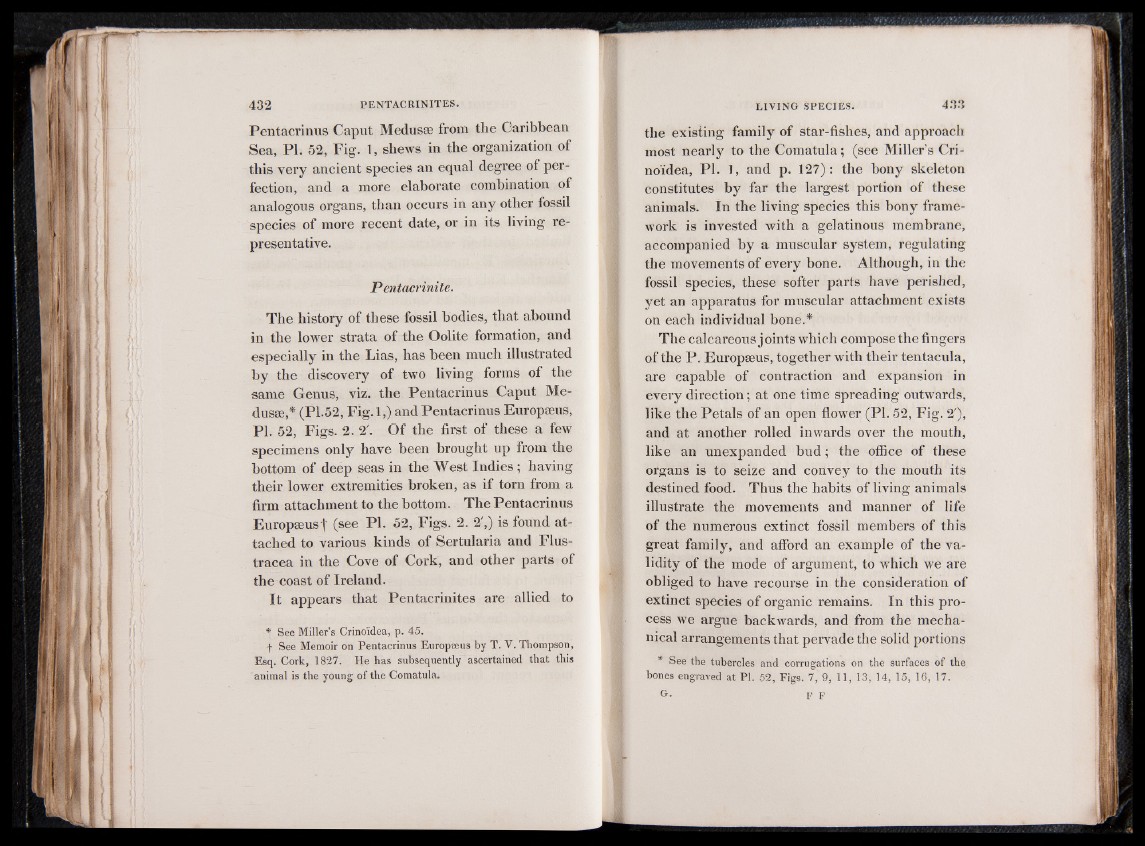
Pentacrinus Caput Medusae from the Caribbean
Sea, PI. 52, Fig. 1, shews in the organization of
this very ancient species an equal degree of perfection,
and a more elaborate combination of
analogous organs, than occurs in any other fossil
species of more recent date, or in its living representative.
Pentacrinite.
The history of these fossil bodies, that abound
in the lower strata of the Oolite formation, and
especially in the Lias, has been much illustrated
by the discovery of two living forms of the
same Genus, viz. the Pentacrinus Caput Medusae,*
(PI.52, Fig.l,) and Pentacrinus Europseus,
PI. 52, Figs. 2. 2'. Of the first of these a few
specimens only have been brought up from the
bottom of deep seas in the West Indies; having
their lower extremities broken, as if torn from a
firm attachment to the bottom. The Pentacrinus
Europseus | (see PI. 52, Figs. 2. 2',) is found attached
to various kinds of Sertularia and Flus-
tracea in the Cove of Cork, and other parts of
the coast of Ireland.
It appears that Pentacrinites are allied to
* See Miller’s Crinoidea, p. 45.
f See Memoir on Pentacrinus Europseus by T. V. Thompson,
Esq. Cork, 1827. He has subsequently ascertained that this
animal is the young of the Comatula.
the existing family of star-fishes, and approach
most nearly to the Comatula; (see Miller’s Cri-
noidea, PI. 1, and p. 127): the bony skeleton
constitutes by far the largest portion of these
animals. In the living species this bony framework
is invested with a gelatinous membrane,
accompanied by a muscular system, regulating
the movements of every bone. Although, in the
fossil species, these softer parts have perished,
yet an apparatus for muscular attachment exists
on each individual bone.*
The calcareous joints which compose the fingers
of the P. Europseus, together with their tentacula,
are capable of contraction and expansion in
every direction; at one time spreading outwards,
like the Petals of an open flower (PL 52, Fig. 2'),
and at another rolled inwards over the mouth,
like an unexpanded bud; the office of these
organs is to seize and convey to the mouth its
destined food. Thus the habits of living animals
illustrate the movements and manner of life
of the numerous extinct fossil members of this
great family, and afford an example of the validity
of the mode of argument, to which we are
obliged to have recourse in the consideration of
extinct species of organic remains. In this process
we argue backwards, and from the mechanical
arrangements that pervade the solid portions
See the tubercles and corrugations on the surfaces of the
bones engraved at PI. 52, Figs. 7, 9, 11, 13, 14, 15, 16, 17.
G. F F